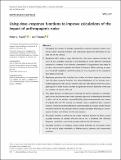Files in this item
Using dose-response functions to improve calculations of the impact of anthropogenic noise
Item metadata
| dc.contributor.author | Tyack, Peter Lloyd | |
| dc.contributor.author | Thomas, Len | |
| dc.date.accessioned | 2019-09-09T08:30:02Z | |
| dc.date.available | 2019-09-09T08:30:02Z | |
| dc.date.issued | 2019-09-06 | |
| dc.identifier | 258702458 | |
| dc.identifier | b3c5bf54-9129-4400-b34c-df815eca3287 | |
| dc.identifier | 85071749652 | |
| dc.identifier | 000484997200017 | |
| dc.identifier.citation | Tyack , P L & Thomas , L 2019 , ' Using dose-response functions to improve calculations of the impact of anthropogenic noise ' , Aquatic Conservation: Marine and Freshwater Ecosystems , vol. 29 , no. S1 , pp. 242-253 . https://doi.org/10.1002/aqc.3149 | en |
| dc.identifier.issn | 1052-7613 | |
| dc.identifier.other | ORCID: /0000-0002-7436-067X/work/61369991 | |
| dc.identifier.other | ORCID: /0000-0002-8409-4790/work/61370049 | |
| dc.identifier.uri | https://hdl.handle.net/10023/18434 | |
| dc.description | Funding: Office of Naval Research, Grant/Award Numbers: N00014‐12‐1‐0204 and N00014‐15‐1‐2553; Scottish Funding Council, Grant/Award Number: HR09011. | en |
| dc.description.abstract | 1. Estimating the number of animals impacted by a stressor typically involves combining a dose-response function with information about the distribution of animals and of the stressor. 2. Regulators often prefer a single threshold to a full dose-response function, but much of the variability observed in the threshold at which different individuals respond to a stressor is an inherent characteristic of populations that needs to be taken into account to predict effects of stressors. When selecting an exposure threshold, regulators need information on the proportion of the population that will be protected. 3. Regulatory processes that calculate the number of animals impacted must draw from the dose-response function, the actual distribution of the animals, and a model mapping how the stressor intensity declines with distance from the source. Ignoring any of these factors can lead to significant errors in estimates of the area and numbers of animals affected. 4. This paper focuses on behavioural responses of marine mammals to anthropogenic sound and demonstrates that a common approach of selecting the threshold at which half of the animals respond (RLp50) grossly underestimates the number of animals affected. We present an example, using a published dose-response function, where the number affected is under-estimated by a factor of 280. Results would be similar for any stressor whose strength decreases following an inverse-square function as it dilutes into the environment. 5. This paper presents a method to use a dose-response function to derive a more accurate estimate of animals affected and to set a threshold (the Effective Response Level) that corrects the problem with the RLp50 estimate. 6. Estimates of effects of stressors should include estimates of uncertainty, which can be used to adapt thresholds to different policy contexts and conservation problems. | |
| dc.format.extent | 1173420 | |
| dc.language.iso | eng | |
| dc.relation.ispartof | Aquatic Conservation: Marine and Freshwater Ecosystems | en |
| dc.subject | Acoustic threshold | en |
| dc.subject | Behavioural response | en |
| dc.subject | Behavioural take | en |
| dc.subject | Dose: response | en |
| dc.subject | Dose-response | en |
| dc.subject | Stressor exposure | en |
| dc.subject | GE Environmental Sciences | en |
| dc.subject | GC Oceanography | en |
| dc.subject | QH301 Biology | en |
| dc.subject | DAS | en |
| dc.subject | SDG 14 - Life Below Water | en |
| dc.subject.lcc | GE | en |
| dc.subject.lcc | GC | en |
| dc.subject.lcc | QH301 | en |
| dc.title | Using dose-response functions to improve calculations of the impact of anthropogenic noise | en |
| dc.type | Journal article | en |
| dc.contributor.institution | University of St Andrews. School of Biology | en |
| dc.contributor.institution | University of St Andrews. Centre for Social Learning & Cognitive Evolution | en |
| dc.contributor.institution | University of St Andrews. Scottish Oceans Institute | en |
| dc.contributor.institution | University of St Andrews. Marine Alliance for Science & Technology Scotland | en |
| dc.contributor.institution | University of St Andrews. Sea Mammal Research Unit | en |
| dc.contributor.institution | University of St Andrews. Sound Tags Group | en |
| dc.contributor.institution | University of St Andrews. Bioacoustics group | en |
| dc.contributor.institution | University of St Andrews. School of Mathematics and Statistics | en |
| dc.contributor.institution | University of St Andrews. Statistics | en |
| dc.contributor.institution | University of St Andrews. Centre for Research into Ecological & Environmental Modelling | en |
| dc.identifier.doi | 10.1002/aqc.3149 | |
| dc.description.status | Peer reviewed | en |
This item appears in the following Collection(s)
Items in the St Andrews Research Repository are protected by copyright, with all rights reserved, unless otherwise indicated.

